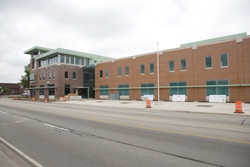
Jonathan Ahl: The incubator will provide physical space with the high-tech accoutrements that high-tech companies need, like wet labs, deep freezes, flame hoods and lots and lots of network capacity. It will also provide the more mundane elements of business, like conference rooms, coffee machines and office space. But the Center will also offer the coaching necessary to get high-tech companies off the ground. The Center is set to open August 1, with space for about 23 starter companies. Wright says they’re on their way to filling the space.
Nancy Wright: We have completed our letter of intent phase and we have about seven letters of intent signed by clients that are interested in space there. After they sign letters of intent, we then forward to them what we call tenant applications. After the application process or the applications are filled out with their business plans, their financial plans, investor status, owner status of the companies, then those go to a review committee or advisory committee that will look at those applications. The goal is to bring companies into the building that stand a significant success level of graduation. That means that those companies move into larger facilities, generate revenue in technology arenas and begin to employ professionals in technology-related jobs. That’s a successful outcome for these companies.
JA: Seven letters of intent. What percentage of capacity does that reflect?
NW: As far as what we would call leasable tenant space for technology companies, we have about 30 percent that is committed now, which is really quite outstanding with a building that hasn’t opened yet.
JA: What are you taking on right now to help ensure that when these companies are ready to leave the Center they stay in Peoria? Not only that they get what they need, but they stay in Peoria. Because we’ve already seen some Peoria NEXT companies are gone.
NW: The first things that we look at are the funding sources. The more investors, both private investors and organizational investors like venture capital firms, the more firms that we have investing in companies in this community, that is one of the biggest roots you can put down to hold a company here. Next is that they have resources in partners, no matter what those partnerships may look like. For instance we are launching an engineering application; we are able to leverage partnerships with Caterpillar and their research talents. We might leverage the resources and hook them to the talents in our medical industry here.
We are looking at growing other programs within the university itself, for instance, like our new entrepreneurship major under the Foster College of Business. It’s another way that we have student interns that these companies can use, and they can get resources, hours of labor that is specific to their industry or their stage of commercialization to leverage them.
Other things we look at to keep our companies here is real estate, developing real estate and resources that they can use. And another thing we look at that we’re really excited about are the other things going on in this community that you know about. For instance, the changes at the Peoria airport, our cultural enhancements, the growth of the marketplace as far as our medical industry, riverfront district, all of those things keep companies with their CEOs and their families hooked to this community.
JA: How much is the public sector going to be expected to help make that happen as well? A lot of people are having a little bit of heartburn over the notion that the city and the county are cosigning multi-million dollar loans for a start-up company that has less than 100 employees. Is that going to be a request that comes up quite a bit as these companies get out of the incubation space? You know, “You did it for Firefly; can you do it for our start-up company as well?”
NW: I was not involved in the due diligence and decision-making of that process, but I do know that that due diligence and decision-making was quite in-depth. We do have to be nimble in our community. We do have to make new paths and new ways of doing business in order to keep technology-based companies here. The leaders in this community, the Peoria NEXT Board of Directors, have a great deal of experience and knowledge that they have gleaned from other research parks, other research areas, other growing urban markets and in economic development. We have some phenomenal leadership in this community who have looked at what has gone on in other regions and how new ways of doing business and new ways of ensuring business have taken root and taken place. So as we move into this particular arena that I’m in, almost every day there is a new way of trying to understand how to do business. This is not…business as usual. We have to be nimble, we have to be flexible, we have to find new ways to keep talented individuals and good intellectual property in this region.
JA: And that could be public involvement, like we’ve seen with Firefly.
NW: I would assume so, yes.
Jonathan Ahl is the News Director of WCBU, Peoria’s listener-supported NPR News and Classical Music station on 89.9 FM. This interview took place on June 28, 2007. IBI

